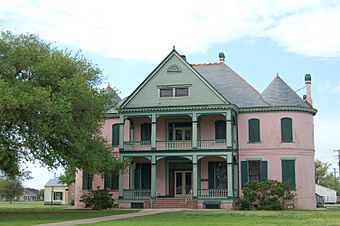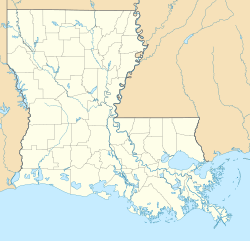Southdown Plantation facts for kids
Quick facts for kids |
|
|
Southdown Plantation
|
|

The restored plantation house as it appears today.
|
|
| Location | Terrebonne Parish, Louisiana |
|---|---|
| Area | less than one acre |
| Built | 1858 |
| NRHP reference No. | 74002188 |
| Added to NRHP | January 18, 1974 |
Southdown Plantation is a very old and important estate in Terrebonne Parish, Louisiana. It was once a large farm where crops like sugar cane were grown. Today, the beautiful main house is a museum where you can learn about its history.
The Start of Southdown Plantation
Southdown Plantation began in 1828. It was founded by William John Minor and James Dinsmore. William John Minor's father, Stephen Minor, was an important secretary to the Spanish Governor of Louisiana, Manuel Gayoso de Lemos.
The land where Southdown was built was first given as a grant by the Spanish government. Before Minor and Dinsmore bought it, brothers Jim and Rezin Bowie owned the land. They started growing indigo there, which is a plant used to make blue dye.
In 1831, sugarcane became the main crop at Southdown. The first sugar mill was built on the plantation between 1830 and 1831. James Dinsmore later sold his share of the plantation. Eventually, William John Minor owned the entire property. By 1852, many people lived and worked at Southdown.
Building the Plantation House
The main house you see today was built in 1858 by Mr. Minor. He named it "Southdown" after a special breed of sheep that his family raised. The house was made from bricks fired right there on the property. The wood came from local cypress and pine trees.
After William Minor passed away, his son, Henry Chotard Minor, made the house even bigger in 1893. He added a second story and beautiful colonnaded walkways, which are like covered porches with columns. In the same year, special glass panels were put into the house. These panels showed pictures of the plantation, palmetto leaves, magnolia flowers, and sugar cane stalks.
At its largest, Southdown Plantation was huge! It had over 10,000 acres of sugar cane fields, a sugar mill, and even a race track. The Minor family played a big part in the sugar industry in Louisiana. They even helped develop a type of sugar cane that could resist a plant sickness called mosaic disease. The Minor family was also known for hosting many fun parties and gatherings at their home.
Southdown in Modern Times
During the Great Depression in the 1930s, the Minor family lost ownership of the house. A company called Realty Operators took over, and later changed its name to Southdown Sugar Inc.
The Southdown sugar mill, which had been so important, closed down in 1979. Its parts were then sent to Guatemala and put back together there, where it continued to operate. This mill was the very last of the 86 sugar mills that had once worked in Terrebonne Parish during the sugar boom of the 1800s.
In 1974, Southdown Plantation was recognized as a very important historical place and was added to the National Register of Historic Places. The next year, the company that owned the property, Southdown Land, gave the house to the Terrebonne Historical and Cultural Society.
While the plantation house was being fixed up, workers discovered the original pink and green paint colors from 1893 on the outside walls. They carefully restored these colors. On June 27, 1982, the plantation house and the old servants' quarters opened to the public as a museum. Now, people can visit and learn all about the history of Southdown Plantation.



